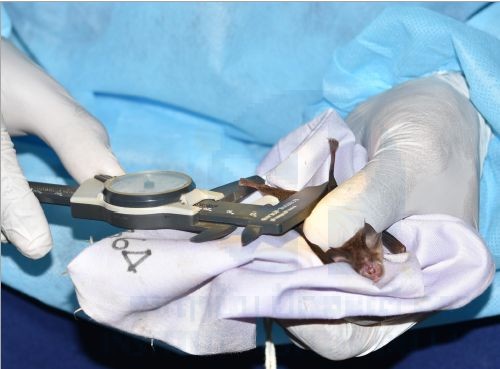BatMap2
Research program funded by the US DOD In collaboration with NMRC-A, Singapore.
 An inventory of bats species in the Lao PDR was an occasion to collect ectoparasites present on bat specimens trapped in caves located in Khammuan and Vientiane provinces. Ticks, flies, and midges found on the different bat species were screened for the presence of arboviruses.
An inventory of bats species in the Lao PDR was an occasion to collect ectoparasites present on bat specimens trapped in caves located in Khammuan and Vientiane provinces. Ticks, flies, and midges found on the different bat species were screened for the presence of arboviruses.
Testing of bat blood samples
A total of 497 samples from bats were collected, including blood, saliva, urine, and anal swabs (stools). Among them 101 blood samples were submitted to arbovirus pan genus RT-PCR. Of these, 25 gave a positive signal for alphavirus sequences, 7 for flavivirus, and 8 for phlebovirus. Possible co-infections were found in 8 samples, within which 7 were positive for both alphavirus and flavivirus sequences and one for alphavirus and phlebovirus.
The preliminary results support the putative role that bats may play in the maintenance of arbovirus transmission in cave environments.
Arboviral screening
Arboviral detection in bat blood samples
A total of 287 bat blood samples, belonging to 6 bat families—Hipposideridae, Megadermatidae, Molossidae, Pteropodidae, Rhinolophidae, and Vespertilionnidae—were screened for arboviruses using RT-nested PCR techniques for the presence of arbovirus sequences (pan flavi, pan alpha, and pan phlebo). Of 287 blood samples, alphaviruses were detected in 25 samples (8.71%), all collected from Hinheup District. Flavivirus sequences were detected in 13 samples (4.53%), all also collected from Hinheup District. Phlebovirus RNA was detected in 11 bats (3.83%), of which 9 were Hipposideridae (8 collected from HinHeup District and 1 from Fueng District) and 2 were Rhinolophidae collected from Feung District.
Arboviral detection in bat ectoparasites
A total of 288 pools of 468 batflies were screened for pan flavi, pan alpha, and pan phlebo. Overall, 10/288 pools (3.47%) were positive for alphaviruses—8/10 (80%) were Streblidae, 1/10 (10%) were Nycteribiidae, and 1/10 (10%) were Spinturnicidae. Flaviviruses were detected in 3/288 pools (1.04%), of which 2/3 (66.67%) were detected from Spinturnicidae, and 1/3 (33.33%) from Nycteribiidae. Only 1/288 pools (0.35%) of Streblidae was positive for phleboviruses.
Next-generation sequencing for identification of viruses in bat mites and batflies








